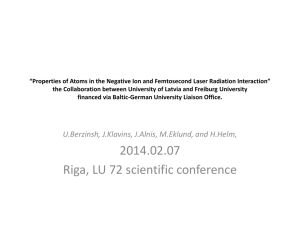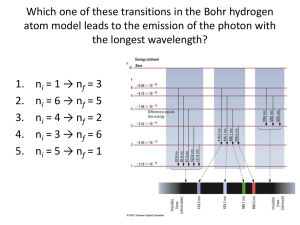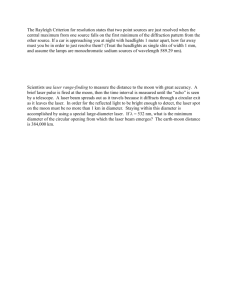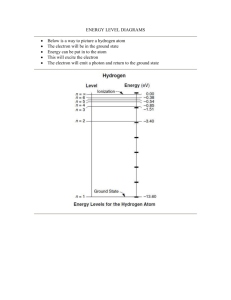3. - IS MU
advertisement
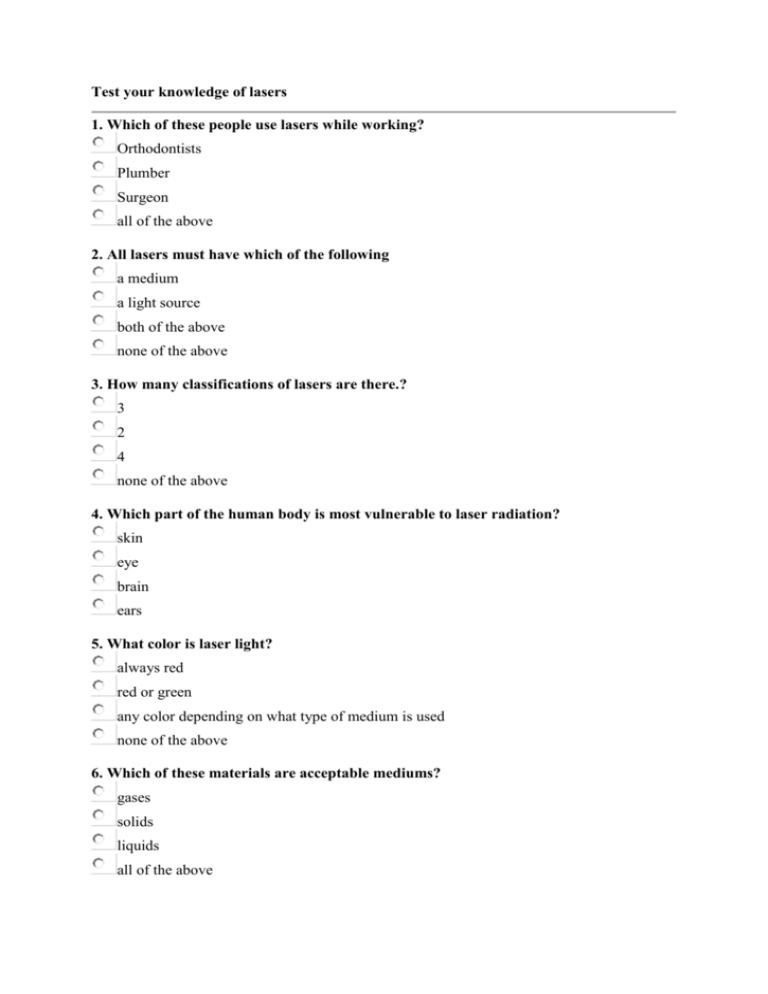
Test your knowledge of lasers 1. Which of these people use lasers while working? Orthodontists Plumber Surgeon all of the above 2. All lasers must have which of the following a medium a light source both of the above none of the above 3. How many classifications of lasers are there.? 3 2 4 none of the above 4. Which part of the human body is most vulnerable to laser radiation? skin eye brain ears 5. What color is laser light? always red red or green any color depending on what type of medium is used none of the above 6. Which of these materials are acceptable mediums? gases solids liquids all of the above Answers: 1b, 2a, 3d, 4b, 5a, 6a 1. What does LASER stand for? Latent Amplification of Stimulated and Elliptical Radons Latent Absorption of Specified Elliptical Radons Light Amplification by Stimulated Emission of Radiation Light Absorption by Simulated Emission of Radiation 2. What particle plays the major role in the process of lasing? Electron Neutron Proton Krypton 3. What do you call an atom whose electrons have reached a higher energy state? Energized state atom Excited state atom Lasing atom Radiative atom 4. When an electron drops down from a higher energy state and recombines with a hole, what is produced? A gamma ray Nothing, they cancel out. A current A photon 5. Laser light has many features different to ordinary incandescent light. Which of these is NOT one of them? Coherent Intensely focused Monochromatic Diffuse 6. What requirement needs to be met before a medium can begin to 'lase'? Threshold voltage Population inversion Equal density of states 100% slope efficiency 7. What is the minimum number of energy levels needed for lasing? 1 3 2 4 8. The wavelength of the laser light is a direct relationship with what feature of the medium? The density of excited state atoms It has nothing to do with the medium The amount of energy levels in the lasing process The energy gap between the excited state and ground state 9. What is NOT a form of laser? Dye Semiconductor Creatine Gas 10. In what decade was the first laser built? 1980's 1950's 1960's 1970's 1. What does LASER stand for? Your Answer: Light Amplification by Stimulated Emission of Radiation This term was coined in the 60's after the MASER - Microwave Amplification by Stimulated Emission of Radiation. 89% of players have answered correctly. 2. What particle plays the major role in the process of lasing? Your Answer: Electron When a photon (a light particle) hits an atom, an electron absorbs the energy from that photon and moves to a higher orbit around the atom. When this atom then encounters another photon exactly the same as the first one, the electron moves back down to its original position and releases the energy it gained in the form of another photon. Thus TWO photons are now present, hence the amplification part of laser. Krypton is a noble gas, not a particle. Protons and Neutrons form the nucleus of an atom. 71% of players have answered correctly. 3. What do you call an atom whose electrons have reached a higher energy state? Your Answer: Excited state atom When an electron reaches a higher orbit after absorbing a photon, it is said to be in an excited state. Only excited state atoms are useful to the lasing process. 76% of players have answered correctly. 4. When an electron drops down from a higher energy state and recombines with a hole, what is produced? Your Answer: A photon As mentioned earlier, when an electron moves back down to its original position, its extra energy is released as light (a photon). 71% of players have answered correctly. 5. Laser light has many features different to ordinary incandescent light. Which of these is NOT one of them? Your Answer: Monochromatic The correct answer was Diffuse Coherent: light waves that are "in phase" with one another. Monochromatic: of one color. All laser light is of one wavelength at a time. Notice the absence of a white laser (mix of wavelengths). Diffuse: light that travels in many directions. All laser light travels in one direction, not like a light bulb which travels in all. Intensely focused: the light is very directional. A laser light has a very tight beam and is very strong and concentrated. A flashlight, on the other hand, releases light in many directions, and the light is very weak and diffuse. 71% of players have answered correctly. 6. What requirement needs to be met before a medium can begin to 'lase'? Your Answer: 100% slope efficiency The correct answer was Population inversion In a laser, there are two important levels, the excited state and the ground state. For lasing to occur, there needs to be a greater amount of electrons in the excited state than in the ground state, and this is given the term population inversion. 40% of players have answered correctly. 7. What is the minimum number of energy levels needed for lasing? Your Answer: 3 Although 2 states would be theoretically possible, in reality its not. While some electrons will be trying to get to the excited state, some will also be dropping back down. These processes interfere with each other so much that a third level is needed. Electrons move up to the excited state, they drop down to a sub level, and then to the ground state, thus avoiding the clash. 38% of players have answered correctly. 8. The wavelength of the laser light is a direct relationship with what feature of the medium? Your Answer: The density of excited state atoms The correct answer was The energy gap between the excited state and ground state The energy gap between the excited state and the ground state determines how much energy the electrons gives away when it drops down. This energy as mentioned then becomes a photon. The greater the energy of this photon, the smaller its wavelength. 55% of players have answered correctly. 9. What is NOT a form of laser? Your Answer: Dye The correct answer was Creatine Creatine is a substance used in bodybuilding to increase the amount of water molecules muscles hold. 45% of players have answered correctly. 10. In what decade was the first laser built? Your Answer: 1960's Schawlow and Townes, both researchers at Bell Labs, invented and patented the theory of a laser in the 50's. It wasn't until 1960 that they actually built one, using a ruby.


